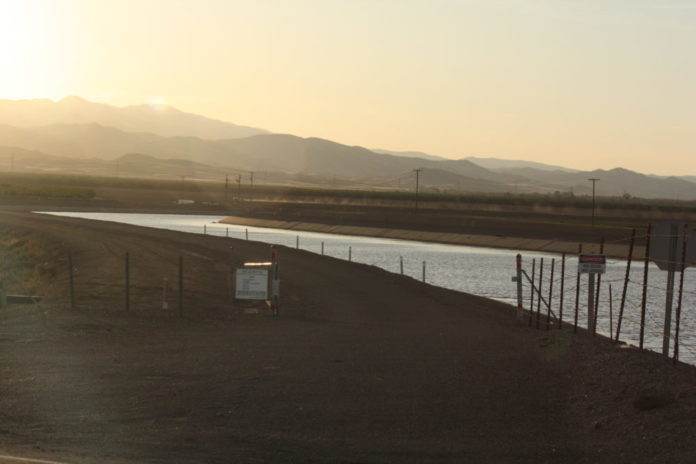 The San Luis Delta Mendota Water Authority held its board of directors meeting on Thursday, May 12, 2022 remotely and I don’t know, most of the board showed to be at its Los Banos headquarters. The remote meeting was held on Zoom and after two years of monkeying with it I’ve discovered an emoji of a hand being held up. It’s many years since I attended public schools but the holding up of a hand to get attention is so ingrained in me I would advocate for making it a requirement to be recognized in Roberts Rules of Order.
The San Luis Delta Mendota Water Authority held its board of directors meeting on Thursday, May 12, 2022 remotely and I don’t know, most of the board showed to be at its Los Banos headquarters. The remote meeting was held on Zoom and after two years of monkeying with it I’ve discovered an emoji of a hand being held up. It’s many years since I attended public schools but the holding up of a hand to get attention is so ingrained in me I would advocate for making it a requirement to be recognized in Roberts Rules of Order.
The Meeting
Chairman Cannon Michael called the meeting to order at 9:33am reading off the boiler plate about public comment and other housekeeping dicta. We all saluted our great nation’s flag and roll call was taken. There was no additions or corrections to the agenda. And there was no public comment although I was tempted to speak up and thank them for providing an online window. The consent calendar was passed.
Lights, Camera, Action Items
The first action item was given by COO Pablo Arroyave about hiring a Professional Management Service contract for the BF Sisk Dam raise and San Luis Reservoir expansion project. He said the Hallmark Group has put in a bid but it was deemed too high. It looks like the reduced amount was acceptable to the Hallmark Group. Good for them. Arroyave said a number of member districts have signed on to this project and urged the others desiring to do so turn in the paperwork. Hallmark will not be managing construction but project management before the steam shovels fire up.
Special Legislation
Buckle up J. Scott Petersen gave a legislation report on HR 5716 Harder. By the time I typed the previous sentence the board had swayed to the approval side under his dulcet tones. I’m not kidding the man could be a news anchor for any national broadcaster.
Next Mike Deas of Watercourse Engineering spoke about the invasive yellow star thistle YST. This is one mean and nasty weed and it turns out it is a huge water thief. It’s root system out competes the native grass for water and is poison to horses. It’ll kill them if they eat it when before it develops spiny thorns that rival cactus. Deas showed a photo of land treated by a selective herbicide. He said there are 15 million acres of YST in California. He said not all soils will support YST. UC Davis has been measuring the density of the weed. I live in predominately cattle grazing area in eastern Fresno County. There is YST up and down the state route and multiple, large 20-acre patches of the plant from hell in the middle of rangeland. There are lots of invasive plants and I understand most of the grasses growing in California rangeland are not native but beneficial. Deas said treatment to eradicate YST works better in normal and wet years. He said there is a way to treat and move it back to relative manageable state.
weed. I live in predominately cattle grazing area in eastern Fresno County. There is YST up and down the state route and multiple, large 20-acre patches of the plant from hell in the middle of rangeland. There are lots of invasive plants and I understand most of the grasses growing in California rangeland are not native but beneficial. Deas said treatment to eradicate YST works better in normal and wet years. He said there is a way to treat and move it back to relative manageable state.
Michael asked if there is any hope the state might pick up some of the costs. That’s not known now. Someone wisely stated the best place to start is Caltrans since it all over the side of roadways. It can be treated with a preemergence. I believe it was Westland’s Tom Birmingham who said many state agencies need to be involved. He asked Petersen what is the next step? And the next step is to gather them into a task request, I believe he said.
Next Petersen introduced Mica Heilmann from Land IQ who spoke about evapotranspiration of fallow fields in the Delta. She said there were numerous landowners who agreed to cooperate with Land IQ on the study to determine ET levels under different weather, fallow land, crop land and other variables. The fallow fields were managed in different ways from more weed growth to less.
Land IQ hires rocket surgeons and brain scientist to take data from satellite images and monitoring stations on the ground, mixes in the land use and figures out how much water is being used per acre. The majority of the land use was either fallow, tomato, pasture or alfalfa. There was also a full map of the Delta’s cropping patterns. I believe the study went from 2018 through 2021. Heilmann noted the managed fallow fields had a consistent and much lower ET rate, the lowest rated observed. The chart showed corn having the highest ET.
Director Gary Kremen of Santa Clara Valley Water District asked if weeds in fallow fields use enough ET to negate any claim that fallowing in the Delta saves water. Heilmann said that can be the case and if I understood, weeds in unmaintained fallow areas have a higher ET than native vegetation. However she also said there are a number of factors including elevation that can impact ET savings. Heilmann said the results of the study showing benefits are not as great as expected. But there is an opportunity to save some water but the connection to groundwater and soil moisture reduces the yield compared to other locations.
benefits are not as great as expected. But there is an opportunity to save some water but the connection to groundwater and soil moisture reduces the yield compared to other locations.
More Legislation
Petersen started the regular legislation report. He said on the fed side the White House has named a new woman as the Environmental Justice post that determines which communities qualify as disadvantaged. There is a caveat that 40 percent of the infrastructure spending goes to DACs. Ok, good for them, what could go wrong with a federal bureaucrat passing judgement on who qualifies for “environmental” justice? I was glad to hear Petersen say there is an effort to ensure Valley DACs are on the radar.
The US Bureau of Reclamation is asking for billions of dollars in the 2023 budget for water needs. The Water Smart Grant terms were released earlier this week. There are more grants for water transfer, small scale water treatment and other related matters.
The Republicans in Congress held a forum on drought in the Western United States where San Luis Water District Director Bill Diedrich, Dan Keppen of Farm Water Alliance and Todd Manly of Northern California Water Association testified. The drought is contributing to food costs around the country.
On the state side it is anticipated Governor Gavin Newsom is expected to release his May budget revision tomorrow. He is expected to ask for more water funds and with the state senate drought fund requests there could be some more real mischief there. The senate wants senior water rights holders to sell their land to the state to help balance the water needs in California. Again, what could go wrong? Speaking of going wrong the California Air Resources Board is coming up with new regulations that will impact municipal fleets down to the pickup size. Petersen said expect this to soon be applied to all public agencies including special district fleets.
needs in California. Again, what could go wrong? Speaking of going wrong the California Air Resources Board is coming up with new regulations that will impact municipal fleets down to the pickup size. Petersen said expect this to soon be applied to all public agencies including special district fleets.
Rusty Areias of Cal Strategy said the amount of surplus at the state level is unprecedented and will put many of the goals into an achievable condition.
CEO Federico Barajas gave his report saying there is progress being made on the geotechnical work on subsidence on the Delta Mendota Canal. The environmental work is coming along also. He asked the lovely and gracious Frances Mizuno to give an update on the San Luis Transmission Project. She said the MOU is almost ready for signing as the design is coming right along. While the Bureau is hip to it there are non-SLDMWA Central Valley Project contractors with some unresolved concerns. She didn’t say Friant. It sounded like Kremen was asking about a backstop agreement to protect SLDMWA. He represents Santa Clara Valley Water District and they have a pretty solid credit rating and he wants to be sure his constituents are protected. He asked if there is any insurance available to protect against a catastrophe. Mizuno said that is being looked into.
Next Barajas spoke about a cost share agreement with the Exchange Contractors, the Los Banos Museum and the Henry Miller family to build a museum that also houses SLDMA and Ex Con offices. The City of Los Banos has given its OK on starting a preliminary design. There will be a June 9th 5pm meeting in Los Banos to look over architectural renderings by stakeholders and other interested folks. I believe it was San Benito County Water Agency’s Jeff Cattaneo who asked who will own the building. Barajas said that has yet to be determined. Its’ a great project with a good location. Some of the best restaurants in Los Banos are in walking distance.
determined. Its’ a great project with a good location. Some of the best restaurants in Los Banos are in walking distance.
Arroyave said accountant Raymond Tarka will soon take over as the new CFO and should be in place by next month. Attorney Becca Ackroyd announced Rebecca Harns will take on the job of assistant attorney. Harns is well versed in SLDMWA matters and will also start by next month.
COO Report
Arroyave said the pump back project is underway to move water upstream on the DMC. He said the Bureau is guardedly confident it can maintain one pump at the Jones plant and if so there won’t be a need for the pump back.
He said bad news, significant precipitation in Yuba County during April will reduce transfers by 60,000 a/f. There might be some water available at the end of the summer. Mizuno said the rains caused the year type to change from a schedule three to schedule four. What does that mean? It means it’s California and it’s water and it’s counter intuitive. Birmingham explained there is a Yuba Accord that provides minimum instream flow. In a dry year Yuba will make releases that can be transferred but the rain took care of the need for those releases and the stored water that would have been released and transferred will not be available. He said purchasing the new inflow runs up against restrictions in pumping. The existing accord will expire 2025 and new negotiations may yield a better result from a new accord. Like I said, counter intuitive.
Next Tom Boardman gave his report saying as of midnight last night Shasta was at 1.82 million a/f and that might be the peak of runoff inflow. It is usually 2.1 million a/f or more at this time. He said the Bureau’s carryover goal for September is 1.1 million a/f and to do that releases will be trimmed by 70 percent or so during this summer. On the other hand Folsom Reservoir is closing in on 900,000 a/f. Folsom will be used more this year since it’s in better shape. Boardman held out the idea there could be some releases in July and August that could result in increased pumping.
Boardman said Jones is running one unit as is the state Banks plant. I think the combined pumping is less than 2,000 cfs. There are pulse flows on the San Joaquin River until May19th under D-1641 standards. I think D stands for decision and is a contractual document dictating how much flows and pumping can take place under defined conditions. He said so far the Bureau is projecting 400,000 a/f or more of releases from Friant to meet Exchange Contractor demands. That could be lessened with more pumping.
Committee Reports
I didn’t hear any committee reports or outside agency reports. Mike Wade gave a report on the California Farm Water Coalition saying handouts for SLDMWA area assembly and state senate districts are ready as a tool to help educate elected officials. He said they have ran another Wall Street Journal advertisement that is getting some attention about water and food supplies. There was a news story about water, food and California by Lester Holt of NBC that included Diedrich and Wade.
Director John Varela reported the recent ACWA conference had good attendance. He said ACWA will be utilizing his district, SCVWD’s diversity and inclusion program and all 10 ACWA regions will support this. During the State Water Resources Control Board https://waterwrights.net/state-board-proposes-office-of-equity-july-26-2021/ hearings on a resolution to incorporate equity into all hiring and decision making ACWA supported the passage. Sounds dangerously close to critical race theory and the concept of equity as a guarantor of outcome verses equality as a guarantor of opportunity. Beware and be aware of the difference.
Michael said the Collaborative Action Plan program is moving along but there are bumps. Varela said ag needs to do a better job of telling its story. Varela represents one of the most vibrant ag areas in the Bay Area and urges a collaborative approach. Wade waded in saying he appreciated Varela’s comment. He also said at ACWA there is an effort to link urban and ag water agencies by sharing information back and forth. Glenn Colusa ID in the Sacramento Valley and Mesa Water District from Southern California are signed up. Michael said with the Covid easing up there can be more tours for elected officials. Someone said during the pandemic vaccine commercials were everywhere. He hopes the government will take the same approach to water awareness.
urban and ag water agencies by sharing information back and forth. Glenn Colusa ID in the Sacramento Valley and Mesa Water District from Southern California are signed up. Michael said with the Covid easing up there can be more tours for elected officials. Someone said during the pandemic vaccine commercials were everywhere. He hopes the government will take the same approach to water awareness.
Ackroyd reported for Petersen saying the San Joaquin Valley Water Blueprint has developed a mission and vision statement. Comments on those statements are due tomorrow, Friday the 13th.
Under board reports Sarah Singleton from SBCWA is retiring and this will be her last meeting. Michael and others said her retirement is the loss of a tremendous asset to the organization.
Michael also said during ACWA he lost count of the amount of praise he heard about SLDM staff and was very proud of the professionalism and competency they practice all the time. Good for him for saying so and good for staff for being so.
At 11:25am the meeting adjourned to go into closed session for what I counted to be 18 items of a legal nature. I’ve been to a few meetings and the vast majority of the time this transition process is perfunctorily performed. Once I heard a farmer named Dennis Prosperi, who is smarter than any four people you can grab and duck tape* together, end the Madera Water Commission meeting he was chairing by asking for a motion and second to adjourn. He ended the meeting by saying, “All in favor get up and walk out of the room.” Michael ended todays meeting in a way I hadn’t heard before. He announced the closed session would commence after a brief biological break. If I ever chair a meeting I intend to use both of those approaches to adjournment. That’s that and go be good to each other.
DISCLAIMER OF RESPONSIBILITY; Waterwrights strives to provide clients with the most complete, up-to-date, and accurate information available. Nevertheless, Waterwrights does not serve as a guarantor of the accuracy or completeness of the information provided, and specifically disclaims any and all responsibility for information that is not accurate, up-to-date, or complete. Waterwrights’ clients therefore rely on the accuracy, completeness and timeliness of information from DAW entirely at their own risk. The opinions expressed in this report are those of the author and do not represent any advertisers or third parties.
*DuckTape, you know like that stuff they make coffee cups out of, Starfoam.
ALL RIGHTS RESERVED. Copyright 2022 by WaterWrights.net/DAW
SAN LUIS & DELTA-MENDOTA WATER AUTHORITY was established in January of 1992 and consists of approximately 2,100,000 acres of 29 federal and exchange water service contractors within the western San Joaquin Valley, San Benito and Santa Clara counties. The governing body of the Authority consists of a 19-member Board of Directors classified into five divisions with directors selected from within each division. The main conveyance is the Delta-Mendota Canal that delivers approximately 3,000,000-acre feet of water within the Authority service area. Of this amount, 2,500,000-acre feet are delivered to highly productive agricultural lands, 150,000 to 200,000-acre feet for municipal and industrial uses, and between 250,000 to 300,000 acre-feet are delivered to wildlife refuges for habitat enhancement and restoration.
Board – Chairman: Cannon Michael,
Staff – Executive Director: Federico Barajas, COO: Pablo Arroyave, Attorney: Becca Ackroyd, Director of Water Policy: J. Scott Pedersen
Email: youtellus@sldmwa.org 209/826-9696
P.O. Box 2157 Los Banos, CA. 93635



































